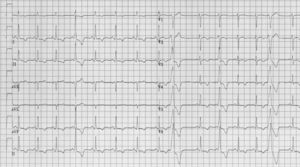Wide Complexes Intervening Regular Sinus Rhythm: Difference between revisions
Jump to navigation
Jump to search
m (New page: {{NHJ| |mainauthor= '''A.A.M. Wilde''' |edition= 2006:12,436 }} Figure 1|thumb A 28-year-old, wheelchair bound, female patient with Friedreich’s at...) |
mNo edit summary |
||
| Line 18: | Line 18: | ||
[[Puzzle_2006_12_436_Answer|Answer]] | [[Puzzle_2006_12_436_Answer|Answer]] | ||
Revision as of 19:25, 8 October 2007
| Author(s) | A.A.M. Wilde | |
| NHJ edition: | 2006:12,436 | |
| These Rhythm Puzzles have been published in the Netherlands Heart Journal and are reproduced here under the prevailing creative commons license with permission from the publisher, Bohn Stafleu Van Loghum. | ||
| The ECG can be enlarged twice by clicking on the image and it's first enlargement | ||
A 28-year-old, wheelchair bound, female patient with Friedreich’s ataxia presents with an irregular heartbeat. She has no history of syncope or dizziness and no other complaints. Physical examination of the heart reveals no abnormalities. There are neither signs of left nor right heart failure. Her pulse is in principle regular, but occasionally some irregularities are observed. The ECG is depicted in figure 1. An echo is normal.
What is your diagnosis?
